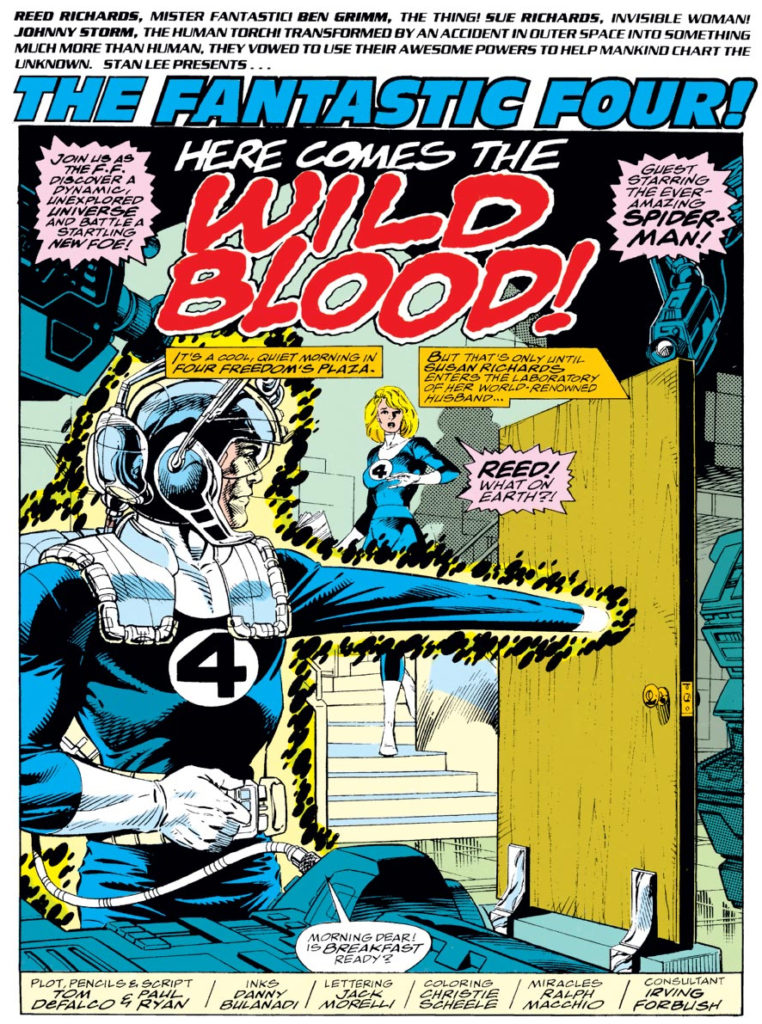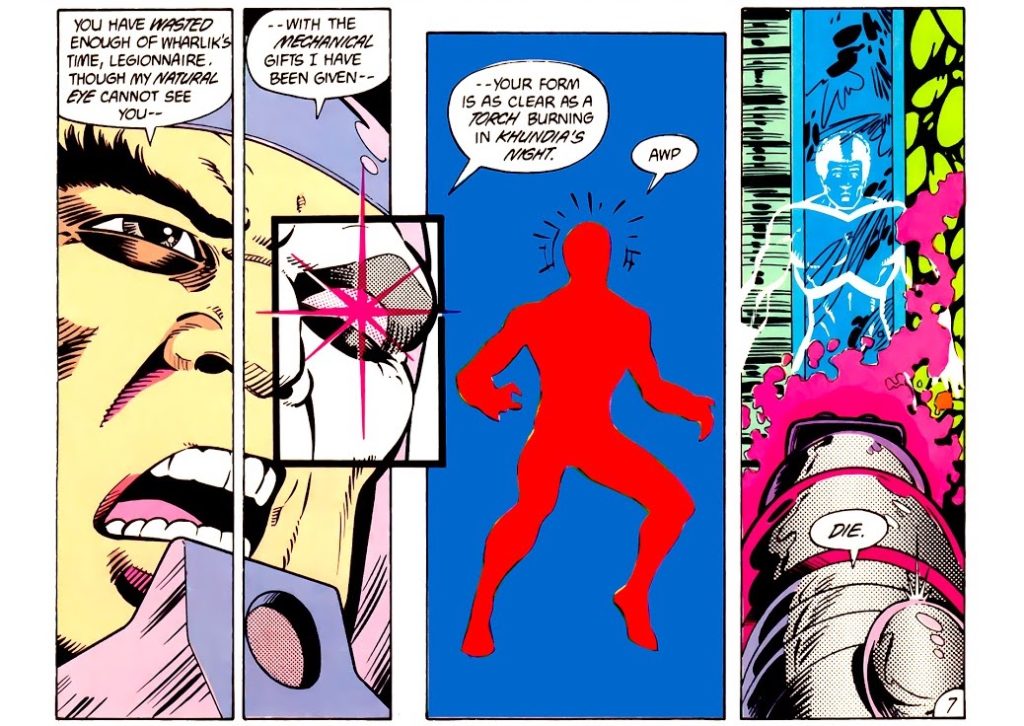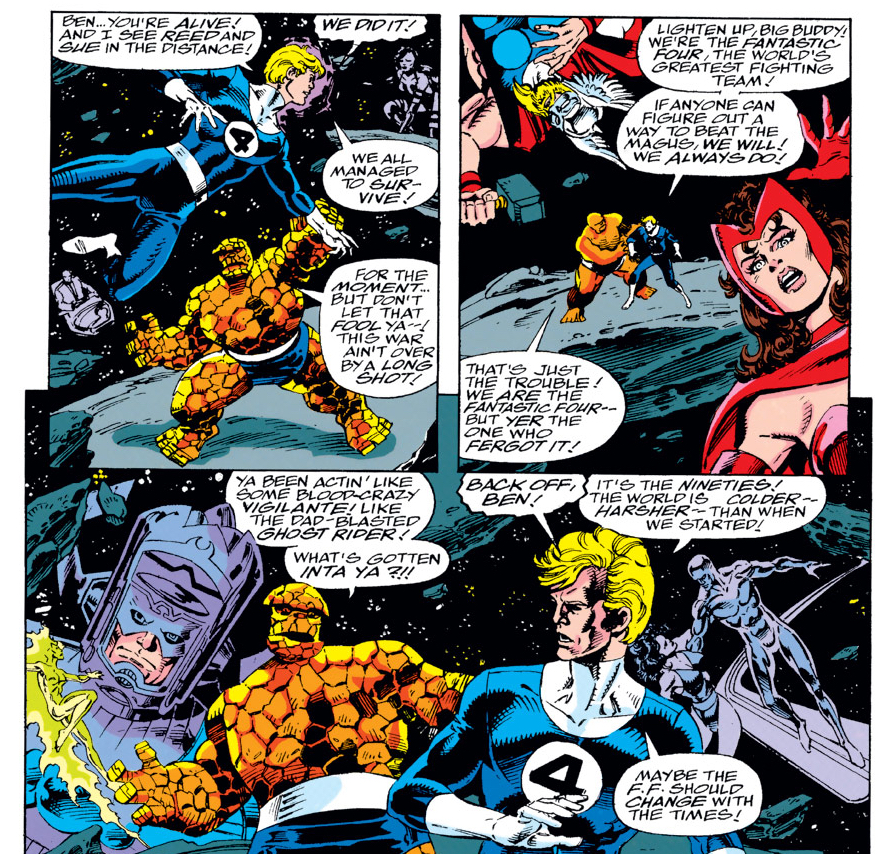Previously on Baxter Building: The beginning of the Tom DeFalco/Paul Ryan run took Jeff and I by surprise by being… not absolutely terrible…? By far the most traditional* take on the team in quite some time, it also wasn’t afraid to shake up the status quo, which it managed by revealing that Johnny’s wife was — gasp — a stinkin’ Skrull, and then she was killed. Oh, and we had shitty Venom, too. No, not regular Venom, who is shitty; an alternate version of Venom who may have actually been shittier, somehow.

0:00:00-0:06:48: As we open — with a tease about what the post-Baxter Building world will look like — we discover that Jeff is mad at me for making him read these issues. Which, you know; fair. Somehow, we also skip ahead to talking about the second storyline we cover in the episode when we ask: Was Tom DeFalco just giving the audience what they want, and in a smarter way than it appears at first glance? (Surely I’m not the only one surprised by how much DeFalco is getting a relative pass in this episode…?)

0:06:49-0:21:40: Despite looking as if we’re about to talk about Fantastic Four #362, we get distracted and talk about one of the reasons why these issues don’t work as well as they should, especially considering our enjoyment of the first DeFalco/Ryan issues last time. The answer…? Perhaps it’s artist Paul Ryan, who gets compared to both Silver Age DC and Don Heck, but not in particularly flattering ways on either occasion. Also discussed: The importance of Joe Sinnott, and the shifting landscape of what a Fantastic Four comic “should” look like.

0:21:41-0:44:42: By the time we get to talking about FF #362, we’re ready to talk about the important stuff: How underwhelming a wooden door can be, interns going above and beyond when it comes to inserting text into a panel, the horror of the Spider-Taint, how science works in the Marvel Universe — spoilers, it involves hot dogs and a curious lack of planning — and just how DeFalco and Ryan recreate the magic of those early Fantastic Four issues by reviving the days when the writer apparently didn’t particularly care to follow what the art was clearly showing if it made one of the heroes look bad. It’s the classic formula from the House of Ideas!


Here’s Occulus in a Legion of Super-Heroes issue from 1985. Or, wait. Is it a Khund? Who can tell.
0:44:42-1:00:44: If you’ve ever thought to yourself, I wish a Marvel comic would rip off the design of the Khunds from DC’s Legion of Super-Heroes, and then apply it to a character that Jeff and Graeme would call Fucking Dull Darkseid, then, good news! Fantastic Four #363 is definitely the comic for you! But that’s not the only joy — or, perhaps, “uh, joy?” — to be found in this issue. There’s also the FF’s new vests! The complete lack of awareness that DeFalco and Ryan had accidentally created an alien world based on video games! Jeff’s somewhat disturbing suggestion that, maybe, Reed Richards deserves a dead son. (Although the fake-out of Franklin maybe being dead is really, really unconvincing.) And, best of all, the worst example of Chekhov’s Gun ever seen.

On the left, the second page of #364. On the right, the last page. Has… anything changed…?
1:00:45-1:08:44: Perhaps you can tell how disinterested both of us were in FF #364 by the fact that we get through it in just eight minutes, and most of that is spent complaining that it basically repeats the same cliffhanger as the previous issue. Sure, part of it is that I skip over the origin story of the planet — really, nobody cares, not even Tom DeFalco and Paul Ryan — but, really: Eight minutes is roughly six more than this issue deserved, and most of the extra is taken up by complaining that Franklin isn’t even in peril this time around.

1:08:45-1:25:10: Even ignoring the fact that the title of Fantastic Four #365 is an outright lie (Really; if your comic is called “With Defeat Comes Death,” it’s only polite to kill someone off), it’s safe to say that the denouement of this storyline isn’t something that we’re enamored with, thanks to Reed Richards’ inability to tell his wife the plan despite having countless opportunities to, a lack of impressive fight sequences and a general air of everything being almost impressively underwhelming. Is this the new norm in terms of quality for the book going forward, or — as Jeff puts it — Paul Ryan simply not having the chops to pull off the fantasy epic that he’d likely been dreaming of since high school, while Tom DeFalco simply didn’t care enough to try hard? We also briefly compare these past four issues to what lies in wait, because we’re definitely on different sides of a divide over the quality of these two stories. (Or, more honestly, which one of two bad stories that we personally find more palatable.)

1:25:11-1:53:15: We end up handling all of Fantastic Four #s 366-370 in one messy bundle, in part because of my distaste for the five-part Infinity War crossover and in part because they’re essentially a collection of somewhat repetitive cut scenes from Jim Starlin’s comic as opposed to something that necessarily would’ve held up to an issue-by-issue synopsis. (In a surprise move, Jeff is less than impressed by Infinity War, which he read because he was inspired by these issues.) While I find the issues incomplete and, in one case, somewhat offensive, Jeff has a good couple of arguments in his favor as he talks about what works about them, whether it’s the metatext that Tom DeFalco is bringing to proceedings, or the Jungian aspect under exploration. “I’m saying, these issues… get a pass because I was interested,” Jeff argues at one point, saying at another, “It’s semi-sort-of organic.” He’s wrong on that last point, but I can’t stay mad at him when he also takes a moment to point out the wonderful sexual innuendo in dialogue that I entirely missed the first time around.

1:53:16-end: As we round towards the end of the show, Jeff brings up sales figures, I get the date of the beginning of Marvel’s sales collapse wrong, and we look ahead to what issues we’re reading next. (#371-381, for those following along at home.) If you’re looking to kill time between now and then, may I recommend our Twitter, Tumblr, Instagram and Patreon? As always, thank you for listening and reading along with these show notes, and feel unafraid to leave comments below.


For those patient enough to wait for this to be posted, here’s the direct link to the episode: http://theworkingdraft.com/media/podcasts2/BaxterBuildingEp43.mp3
I don’t mean this as an insult and I’m not saying it to be mean, but why are you guys reviewing what are essentially quarter bin comic books? Just being honest but your lack of enthusiasm makes this sound like a chore and frankly it’s kind of a chore to listen to. I have to laugh, because in contrast, I remember when you were reviewing the Avengers run and spent like 5 minutes on the Kree-Skrull War issues. And your conclusion was that it wasn’t as good as you remember when you read it when you were younger! Sigh.
This might be a hot take I am unsure but a boring comic is always worse to me than a bad comic because in a bad comic there is something going on and boring comics are inert and really bum me out
I read the Infinity War tie-ins when I read the main story (with many others). I enjoyed that it seemed to be consistent with the main story but elaborated on it. When read with a bunch of other stuff, it doesn’t feel as repetitive. That being said, I found 368 to still be a waste of time from the perspective of the Infinity War story itself.
Perhaps it says something about these issues when one of the more interesting things for me was that issue 369 featured a letter from Dale Friesen, who now runs a Dungeons and Dragons campaign that’s streamed on the official D&D Twitch channel. Here’s the first episode: https://www.youtube.com/watch?v=wvy-vBQ9ggc
Having listened to the podcast:-
= Not a chore to listen to for me! I thought this was one of the best episodes yet. Particularly the discussion of sales. More of that sort of thing, please — it gives me a very different perspective on what, when reading these issues, felt like an extreme level of smug complacency to realize that, at the time, the creators probably felt like the thing was cratering.
– But OK, although I think our hosts got across the dullness of these issues, I think they didn’t get to grips with the sheer bloody superfluity of them. These are among the most *unnecessary* comics that I’ve ever read. In that sense, their dullness (good stuff in the podcast on Ryan’s lack of visual flair) is really quite sensitive to the material. There’s nothing here to get excited about.
Despite that, these comics did give me a heartcrushing moment of disappointment, so I can’t say they had no emotional impact on me.
So, quite astonishingly superfluous. I think the thing that sums that up for me is that we have not one, but two, covers in which the Thing is shouting “It’s clobberin’ time.” There’s absolutely nothing there except for, “This is a Fantastic Four comic, and it will have in it the sort of things that you recognize as things that happen in a Fantastic Four comic.”
Which is exactly what that first story arc about Occulus and Wild Blood and the Inniverse is, and it’s *everything* that it is. (From now on, the main Marvel universe will be known as the Outiverse.) It adds nothing. It’s just a bad Kirby cover. And it’s more than a bad Kirby cover, it’s some sort of bizarre inversion of a good cover of something. Instead of breathing new life into aspects of the model and updating them to fit a different context, it’s draining all life out of the original, leaving us with something that, like a zombie, shambles through the motions of what a Fantastic Four comic is “supposed” to be like.
Honestly, I could not have asked for more compelling evidence for my main belief about the FF: that, on the one hand, it’s horribly susceptible to stories that are based in nostalgia, because everyone feels the compulsion to look back to that shining Silver Age period (plus, it’s about family, guaranteed to trigger our association of superhero stories with our childhood) — but on the other, nostalgia is exactly what kills the Fantastic Four stone dead, because what made that Silver Age Lee/Kirby period so shining was that it was about the new and the future.
And then, I started reading the next story, and for a moment I thought I’d got it all wrong, and things were going to be OK. The thing was, I’m reading these on Unlimited, and I didn’t look carefully at the cover. So what greets me on the first page?
The Magus, with little statuettes 0f the Fantastic Four! “The Magus! He’s in the category of things that are ‘supposed’ to be in a Fantastic Four comic!” I think to myself.
And for me it seems so interesting. Because (an opinion that I’ve bored people with here before) I think the real nemesis of the Fantastic Four is the psychedelic era. The Fantastic Four are quintessential early ‘60s creations, and at the time, that was no bar to them also being about newness and change and possibility. Quite the reverse — that was the period’s sense of itself. But the FF become horribly dated the moment those things involve imagining Reed Richards doing LSD.
But that would make confronting them with Jim Starlin really interesting. And Starlin (for me) at his best represents the opposite of the previous arc. He’s the guy who does Kirby influence right, who takes Kirby stuff, reshapes it with his own sensibility, and finds things in it that Kirby himself doesn’t.
And what’s the Magus in particular about? Well, lots of things, but among them is the idea of a nightmare future that you don’t want to become. And Adam Warlock actually originates as an FF character at the tail end of the Kirby era, right? The Magus is a *great* antagonist for the FF. Why hasn’t anyone done this?
And I’m starting to think that maybe the point of the previous story was to do all the Kirby stuff as straight as possible to contrast with this, that DeFalco and Ryan were playing a long game, and that I had completely misjudged them. Maybe this was going to be the comic that actually wrestled with things that the FF can’t handle, and said “You know what? It can handle them just fine, and we’ll show you how. Reed can too do acid.”
Because I didn’t know it was a crossover.
In my defence, those little things in the top right-hand corner of the covers that tell you about Infinity War are tasteful and understated, and easy to miss. But I hit the second page, and something feels off, as if I’m expected as the reader to know things about this story that it hasn’t established. Uh oh. I go back to the cover and look at it more carefully, and there it is: “An Infinity War Crossover.”
And all that exciting possibility was ripped away.
I am impressed with DeFalco and Ryan’s commitment to Lyja/Johnny as the OTP, though.
This was a very lovely analysis, Voord. And of course, despite it being one of my favorite FF stories, I totally forgot the Him!/Warlock/Magus connection.
(And by “it,” I of course mean the debut of Him!, not the Infinity War crossover we just discussed.)
I bought every issue of Infinity War – Infinity Gauntlet was so good, and the new series had way more characters in it!- but I don’t remember much beyond the evil doppelgängers, the superfluousness of the heroes, someone calling Jean Grey “Marvel Woman” for (maybe) the only time, and the Magus’s stupid man bun. The series made me reassess my opinion of Ron Lim (from great to eh), and made me hesitant to read anything else written by Jim Starlin (except for the classics).
6 double-sized issues- what a waste of time and money! Rick Vance is right that a bad comic is better than a mediocre comic. I’m not mad I spent money on at least 5 issues of Youngblood, but I’ll never get the back the $15 Infinity War cost me. I feel bad for anyone who came out of the movies and picked up the trade.
Great episode as usual guys! I actually bought a few issues you’ll cover in the next episode that I don’t really remember, so it’ll be interesting to hear how bad they actually were.